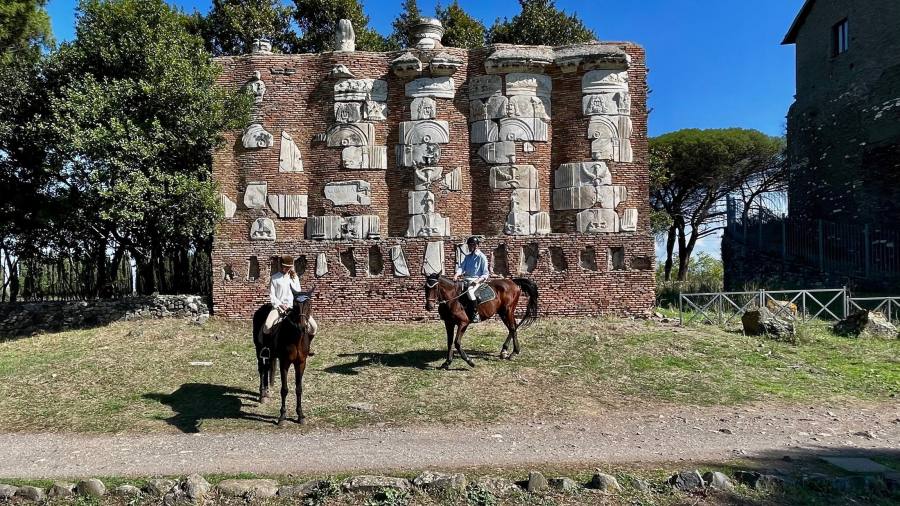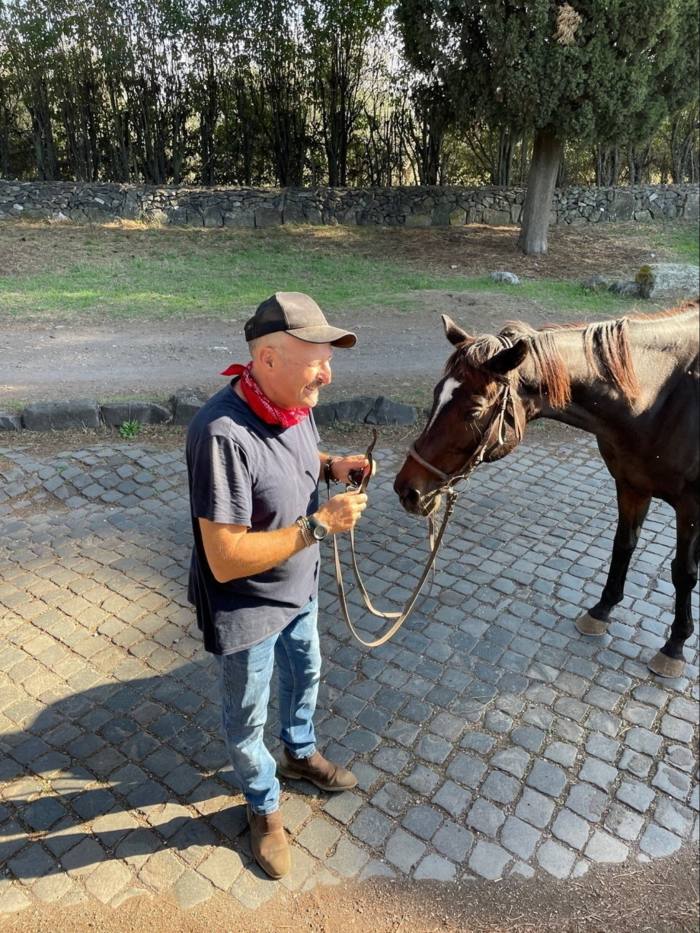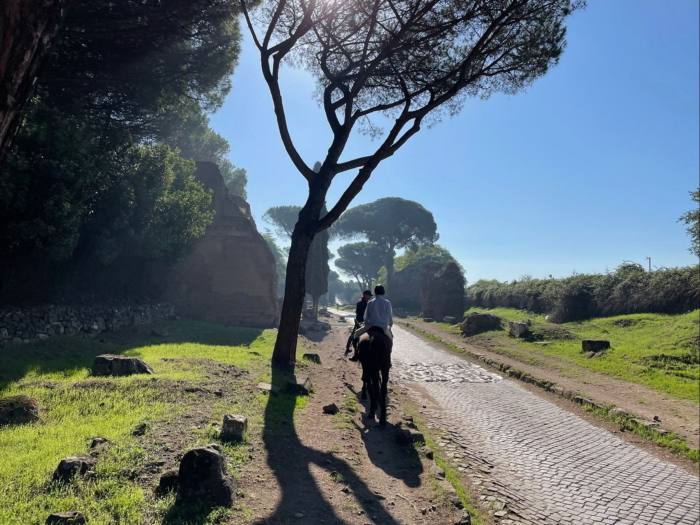
How do you best celebrate an anniversary? Flowers are a traditional part of the answer and even in November there has been no lack of them. I could have picked memorial bunches of pink and yellow dahlias, blue King George daisies, no end of pink nerines and green and black Salvia discolor, whose leaves smell of blackcurrants. Instead of saying it with flowers, I decided to say it with horses.
For this anniversary they are the right call. Nineteen years ago, I served at the front of the cavalry in Oliver Stone’s epic 2004 film Alexander, first in the Moroccan desert, then in Thailand. In Morocco, I led the crucial breakthrough for Alexander during his great victory over the Persian army. In Thailand, I joined a charge against war elephants, galloping for Alexander through a vast botanical arboretum while 20 elephants stormed out of a man-made jungle, planted with shrubs that they would not then eat. If the charge had to be refilmed, the jungle had to remain intact.
Hollywood is a hard act to follow but anniversaries can be less frenzied than what they commemorate. In Rome I have just found a placid sequel: in heavenly sunshine I have ridden down Rome’s ancient Via Appia, partly closed to cars and still surfaced with some of the original slabs. Ancient tombs flank the roadway: there is not an elephant in sight.
At the city’s end of it, Riding Ancient Rome is a dream destination, especially for a cavalryman who once showed off to Angelina Jolie and put ideas of ancient warfare to the test. By email, ([email protected]) Lorella matches applicants’ weight, height and experience to times and horses and maintains encouraging email contact before and after the event. Out of reach of Rome’s traffic, clients then ride into rolling open country, like centaurs in the Campagna.
I recommend the top of the range, the four-hour personalised ride, guided by Sandro Bernardini, a star whom Warner Bros has yet to discover. When not on a horse he is a contract gardener: his stable yard is flanked by a courtyard full of flower pots and tumbling bougainvillea. He is also a knowledgeable guide to the road’s antiquities: unaware, we have been moving in parallel all these years.

In imperial Rome, the emperor’s horseguards lived in barracks up on the Caelian Hill. Trajan had 1,000 of them and many were German. A century later, Septimius Severus doubled them to 2,000, remains of whose barracks are still visible under Rome’s great church of Saint John Lateran, one of the ancient city’s best-kept secrets.
No emperor myself, I brought my personal guard not from the German Danube but from Istanbul: Harriet flew in for the venture, veteran of our ride through the high mountain flora of Kyrgyzstan six summers ago. The emperor’s guards never rode on duty down the Via Appia as if it was their Horseguards Parade. Nonetheless, some of them hunted wild boar in the fields beside it. Women in imperial Rome did not hunt on horseback, but if Harriet had been an ancient Roman she would have galloped home with a trophy tusk.
Sandro stables his horses down an unpromising side road, the Via dei Cercenii, behind a low gate at number 15 on land leased since the 1960s from the Comune di Roma. Less than a mile from the madness of Rome’s traffic, the yard could be in rural Dorset, with a tack room, straw bales and exactly the sort of mounting step the over-70s are glad to find. I climbed on to Zorro, a well-behaved bay, and Harriet sprang on to darker Quitace: Sandro set the pace and out we went.
To avoid the traffic we began on a side road while Sandro oriented us over his shoulder. Through rapid Italian and the clatter of hooves I heard “Gina Lollobrigida, Sophia Loren”: they own houses and land along our route. If I had also heard Claudia Cardinale, my Holy Trinity would have been complete. Dreaming of angels on horseback, I settled into Zorro’s trot, hoping we might turn into the campagna and gallop over Lollobrigida’s ridge and furrow.
At the point where it closes to cars, the ancient Via Appia has the charm of a landscape garden. Since the mid-19th century, plantings of vertical cypresses and flat-headed pine trees have given it the classic Italian look. The pines are Pinus pinea, whose head resembles a giant mushroom. It was the comparison used by Pliny, a witness, for the mushroom-shaped cloud that rose from volcanic Vesuvius when it destroyed Pompeii in AD79. Between some of the pines wild cyclamen and yellow sternbergias flower in grass beside the road.
In 312BC, the censor Appius Claudius forced work on this road to begin, allegedly without itemising the cost. Was the Via Appia a Roman prequel to the UK’s dire project for a trainline, HS2? It too was built over many years in stages: it was an exceptional feat of engineering and when finished, it ran for about 350 miles, linking Rome to faraway Brundisium in the south-east of Italy. It may have had an economic role but its first function was military and political, to make recent Roman settlements accessible, first as far as Capua, then right down to Brindisi.
In the 1850s, Luigi Canina was named commissioner of antiquities and did a fine job of restoring the road. Beside it, he erected brick facades on which he fixed marble fragments of ancient monuments. We posed beside one of them and its ancient Roman family portraits while Sandro explained their history. We then circled in front of Canina’s Casal Rotondo, built beside a mausoleum that some scholars link to the consul of AD32, a patron of the poet Tibullus.

Persons and texts from my years of teaching Roman history came into sharper focus between Zorro’s ears. Portrait busts and an inscription commemorate two ex-slaves of a truly slippery financier, a moneylender to one of the last of the Ptolemies whom Caesar obliged poor Cicero to defend in court in 54BC. The portrait head of a third was later replaced with the head of a woman, a priestess of the goddess Isis. The ancients had no scruples about recycling honorific statues.
We took a loop right handed into open country, flying at a gallop only a mile or two from Rome’s speed limit. In a great poem, Robert Browning evoked “two in the campagna” and the flowers of fennel in the nearby brickwork. We were three, with fennel beside our horses’ hooves. If a treacherous Gaul had appeared on the hillside, threatening the local estate owners, I would have ridden him down and kept my Trinity of stars safe.
Forget the forum: Riding Ancient Rome is much more fun. Parts of the Via Appia are open to bicyclists but iron horses are a poor substitute for the real thing: Zorro trotted imperiously past them as they bumped on the road’s rough paving. Then, back in his yard, Sandro played his final card.
While we talked of gardening, seated at a table, his grooms brought fresh tomato bruschetta, fruit and white wine. In a riding centre in the Cotswolds I would be lucky to be offered a Mars bar.
Sophia Loren had plainly been having a secluded morning but even without her it was an anniversary ride from heaven.
Find out about our latest stories first — follow @FTProperty on Twitter or @ft_houseandhome on Instagram